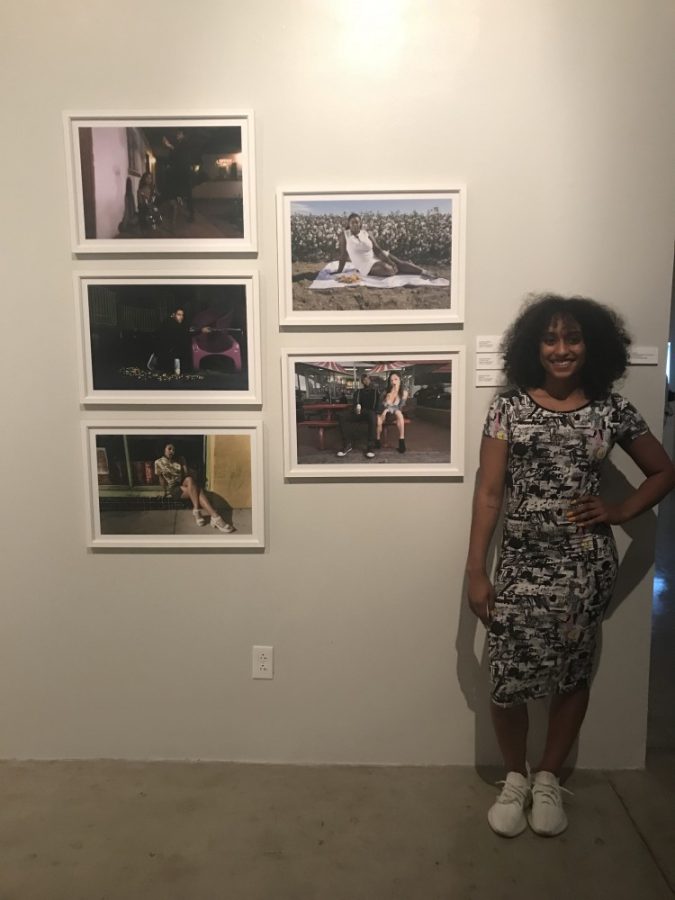Former University of Arizona gymnast Kennady Schneider has found her voice in the contemporary art of photography and is using it to represent the black community.
Schnieder closed her very first solo exhibition “Seasoned” at the Lionel Rombach Gallery on the UA campus last Thursday and recently won the Julia Margaret Cameron Award in Contemporary Portraiture for her photo series “#Black”.
Schneider came to UA as an athlete and an aspiring journalist but quickly found that her heart was never in reporting. Rather, her vocation had always been in performance art.
“I loved choreographing and performing in front of people. My whole life is centered around the arts,” Schneider said.
Schneider retired from gymnastics last March and is now dedicating her time and energy to a different kind of art.
RELATED: Getting a taste of UA’s Student Union
“I realized I could use photographs as a way to have my voice be heard,” Schneider said. “Photographs are a visual language I could communicate through very well.”
Schneider considers herself a portrait photographer, but she said she strives for a sense of purposefulness in every piece. She enjoys “being on set” in previsualized, staged photoshoots where she can interact with and direct her participants and the environment to showcase her ultimate message.
Schneider’s subject: “the black experience.”
“In my work I’m always trying to showcase the black experience,” Schneider said. “Social injustices, oppression, exploitation, the systematic erasure of the black body throughout history.”
As a black woman in gymnastics, Schneider felt isolated in a sport that, historically, is predominantly white.
“Every representation of the ideal gymnast is white,” Schneider said. “And that can make a black gymnast feel like she doesn’t belong in this space.”
RELATED: This Week in Astrology
In her solo exhibition, many of her photos featured portraits of her competitors. After every competition, Schneider would ask her fellow competitors if they would like to be featured in a project to demonstrate the lack of diversity in gymnastics.
While building that project, Schneider said she determined that there was a disappointing lack of diversity in gymnastics, but she also found something more meaningful.
“I found that there was this sense of community that I hadn’t been accessing,” Schneider said. “Seeing that kinship trickle down to our contemporary moment in this sport that I was participating in was so interesting and fulfilling for me.”
Schneider’s exhibit, “Seasoned,” has already closed, but her winning photo series, “#Black,” will be featured in the 12th edition of the Julia Margaret Cameron Collective Exhibition in Barcelona, Spain, this April.
According to the UA School of Art website, 760 photographers from 72 countries submitted a total of 5,800 photographs for consideration for the award.
Schneider missed the initial notification of her win.
RELATED: UA nursing prof. develops child-abuse screening program
“The news got lost in my emails. I think it was three weeks later that I actually figured out I had won,” Schneider said. “I was so shocked. I know my work is good, but it’s hard to know what jurors look for.”
“#Black” marked a jumping off-point in Schneider’s life as an artist. Initially, she was experimenting with her style and her message. She knew what she wanted to see, though, and worked intuitively.
She began doing research into African American history, aided by her minor in Africana studies. When she looked into how the black body was portrayed in media, she found her footing in this project.
There are seven photosin her series depicting common African American stereotypes in history:
A black man and white woman — he in a rear-facing snapback with vanilla ice cream dripping through his fingers and she in revealing clothes and hoop earrings unabashedly licking a chocolate ice-cream cone.
A fashionably dressed woman in heels, biting her sunglasses, the word “woke” written across her brow in permanent marker.
A woman in a white dress in a cotton field, a pile of fried chicken dirtying her picnic blanket.
A boy at a playground in the dark, holding a gun, rainbowed Skittles littered at his feet.
A man in furry coat and crouching beneath him, a women all in gold.
A man lazing at the pool, clad in sweats and a white tank top.
Five men, dressed in hoodies or jersies, dark jeans or sweatpants, snapbacks or bandanas, huddled on a dilapidated street corner.
“It’s taking all of these stereotypes in history and displaying them in the contemporary moment, as is relatable to my viewers,” Schneider said.
Schneider hopes her audience sees representation where there was once none and are encouraged to ask questions about system-based institutions and the history of dehumanization of the black body.
Schneider’s work will always be in continuation, she said. Her work will never end, nor will this series. It will change and mold itself as she changes.
Schneider graduates this May. She hopes to see herself working at a gallery or museum in the future and possibly continuing as an artist in academia.
“I think being around active, young minds all the time and being a mentor to these voices is what I feel like my duty is,” Schneider said. “As a black woman, I never had that representation in higher education. It feels like it’s a service I want to do for future artists and minds who want their voices heard.”
Follow Daily Wildcat on Twitter









